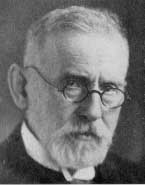Paul Ehrlich
(1854 - 1915)

Paul Ehrlich was born on March 14, 1854, in Strehlen, Germany. Already as a pupil and student of medicine he was interested in coloring microscopic tissue substances. In his dissertation at the Leipzig university he picked up the topic again ("Beiträge zur Theorie und Praxis der histologischen Färbung"). After his clinical education and habilitation ("Das Sauerstoffbedürfnis des Organismus") at the Charité in Berlin in 1887, he received a call from Robert Koch to join the Institute for Infection Diseases in Berlin (1891).
Paul Ehrlich overcame the tuberculosis disease, with which he was infected in Egypt. Thereafter he worked with his friend Emil Adolf von Behring to contribute to the development of the diphtheria serum that would help against such respiratory illnesses.
These works were inspirations to his famous side-chain theory (Seitenkettentheorie) from 1897. This theory explained the effects of serum and allowed to measure the amount of antigen. In 1896, Ehrlich became the director of the newly founded Royal Institute of Serum Research and Examination (Königlichen Instituts für Serumforschung und Serumprüfung) in Steglitz (Berlin). There he continued his work on immunology and haemolysins; these studies ultimately led to his side-chain theory of immunity. In 1899, the institute was moved to Frankfurt (Main) and extended into the Institute of Experimental Therapy (Institut für experimentelle Therapie). Here Ehrlich researched chemotherapy and infectionious diseases. In 1904, Ehrlich became honorary professor of the University of Göttingen.
Paul Ehrlich received the Nobel Prize for Medicine together with Elie Metschnikoff in 1908 for their research on immunity. In 1906, he discovered the structural formula of atoxyl, a chemical compund that had been shown to be able to treat sleeping sickness. Following this discovery, he tried to create a less toxic version of the medicine. In 1909, he and his student Sahachiro Hata developed Salvarsan, a medicine for sleeping sickness, syphilis and other epidemic diseases.
He was honored by the Prussian government in 1911, when he was elected to the highest rank of Excellency in the Privy Medical Council. A few years later, Ehrilch died on August 20, 1915, at the age 61.
His life is depicted in the movie The Magic Bullet, which focused on Salvarsan® (arsphenamine, "compound 606"), his cure for syphilis. His work raised awareness of the existence of the blood-brain barrier, a physical barrier between the blood vessels in the central nervous system.
The "magic bullet" concept comes from the experience of 19th century German chemists with selectively staining tissues for histological examination, and in particular, selectively staining bacteria (Ehrlich was an exceptionally gifted histological chemist, and invented the precursor technique to Gram staining bacteria). Ehrlich figured that if a compound could be made that selectively targeted a disease causing organism, then a toxin for that organism could be delivered along with the agent of selectivity. Hence, a magic bullet would be created that killed only the organism targeted.
Sources: Wikipedia; Wikipedia Image; Nobel Prize Biography


